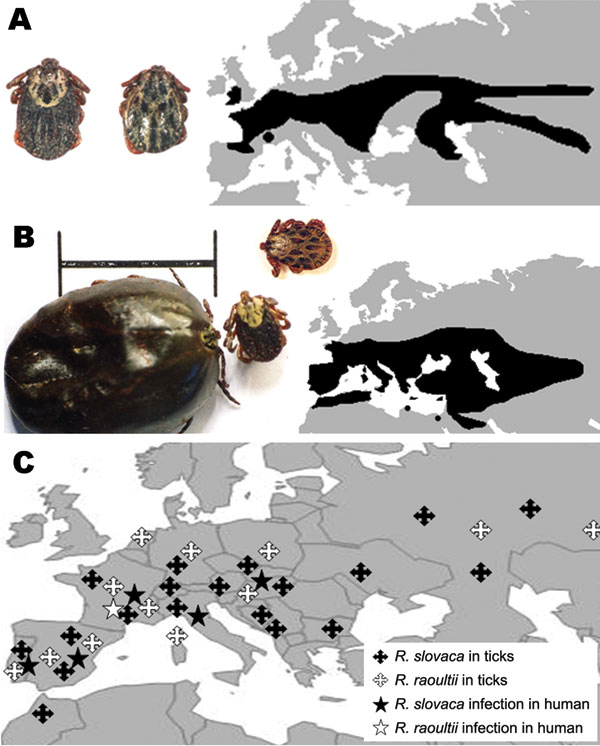Volume 15, Number 7—July 2009
Dispatch
Rickettsia slovaca and R. raoultii in Tick-borne Rickettsioses
Figure 1

Figure 1. Dermacentor reticulatus, the ornate dog tick (A) (female, left; male, right), and D. marginatus, the ornate sheep tick (B) (engorged female, left; unfed female, center; male, right; scale bar = 1 cm), and their distribution. D. marginatus is most frequently found in Mediterranean areas of Europe with dense bush and tree cover and is common under oak and pine vegetation. It also has a restricted distribution in North Africa, in the cooler and more humid areas associated with the Atlas Mountains. Adults infest large mammals such as sheep, cattle, goats, and wild boars. Larvae and nymphs feed mostly on small mammals and medium sized carnivores. D. reticulatus is most frequently found in colder northern areas of western Europe and the former Soviet Union, with high humidity and mild winters. D. reticulatus is primarily a tick of dogs and carnivores, but it can be found on ungulates such as sheep, cattle, and horses (9). D. marginatus and D. reticulatus have been suggested as reservoirs of R. slovaca and R. raoultii, which are maintained in ticks through transstadial and transovarial transmission. Therefore, the geographic distribution of these rickettsiae likely parallels that of Dermacentor ticks (C).
References
- Parola P, Paddock C, Raoult D. Tick-borne rickettsioses around the world: emerging diseases challenging old concepts. Clin Microbiol Rev. 2005;18:719–56. DOIPubMedGoogle Scholar
- Raoult D, Berbis P, Roux V, Xu W, Maurin M. A new tick-transmitted disease due to Rickettsia slovaca. Lancet. 1997;350:112–3. DOIPubMedGoogle Scholar
- Raoult D, Lakos A, Fenollar F, Beytout J, Brouqui P, Fournier PE. Spotless rickettsiosis caused by Rickettsia slovaca and associated with Dermacentor ticks. Clin Infect Dis. 2002;34:1331–6. DOIPubMedGoogle Scholar
- Mediannikov O, Matsumoto K, Samoylenko I, Drancourt M, Roux V, Rydkina E, Rickettsia raoultii sp. nov., a spotted fever group rickettsia associated with Dermacentor ticks in Europe and Russia. Int J Syst Evol Microbiol. 2008;58:1635–9. DOIPubMedGoogle Scholar
- Ibarra V, Oteo JA, Portillo A, Santibanez S, Blanco JR, Metola L, Rickettsia slovaca infection: DEBONEL/TIBOLA. Ann N Y Acad Sci. 2006;1078:206–14. DOIPubMedGoogle Scholar
- Parola P, Vestris G, Martinez D, Brochier B, Roux V, Raoult D. Tick-borne rickettiosis in Guadeloupe, the French West Indies: isolation of Rickettsia africae from Amblyomma variegatum ticks and serosurvey in humans, cattle, and goats. Am J Trop Med Hyg. 1999;60:888–93.PubMedGoogle Scholar
- Gouriet F, Rolain JM, Raoult D. Rickettsia slovaca infection, France. Emerg Infect Dis. 2006;12:521–3.PubMedGoogle Scholar
- Tissot-Dupont H, Raoult D. Q fever. Infect Dis Clin North Am. 2008;22:505–14. DOIPubMedGoogle Scholar
- Estrada-Pena A, Bouattour A, Camicas JL, Walker AR. Ticks of domestic animals in the Mediterranean region. Zaragoza (Spain): University of Zaragoza; 2004.
- Ibarra V, Portillo A, Santibanez S, Blanco JR, Perez-Martinez L, Marquez J, DEBONEL/TIBOLA: is Rickettsia slovaca the only etiological agent? Ann N Y Acad Sci. 2005;1063:346–8. DOIPubMedGoogle Scholar
- Marquez FJ, Rojas A, Ibarra V, Cantero A, Rojas J, Oteo JA, Prevalence data of Rickettsia slovaca and other SFG rickettsiae species in Dermacentor marginatus in the southeastern Iberian peninsula. Ann N Y Acad Sci. 2006;1078:328–30. DOIPubMedGoogle Scholar
- Dautel H, Dippel C, Oehme R, Hartelt K, Schettler E. Evidence for an increased geographical distribution of Dermacentor reticulatus in Germany and detection of Rickettsia sp. RpA4. Int J Med Microbiol. 2006;296:149–56. DOIPubMedGoogle Scholar
- Vitorino L, De SR, Bacellar F, Ze-Ze L. Rickettsia sp. strain RpA4 detected in Portuguese Dermacentor marginatus ticks. Vector Borne Zoonotic Dis. 2007;7:217–20. DOIPubMedGoogle Scholar
- Nijhof AM, Bodaan C, Postigo M, Nieuwenhuijs H, Opsteegh M, Franssen L, Ticks and associated pathogens collected from domestic animals in the Netherlands. Vector Borne Zoonotic Dis. 2007;7:585–95. DOIPubMedGoogle Scholar
- Marquez FJ. Spotted fever group Rickettsia in ticks from southeastern Spain natural parks. Exp Appl Acarol. 2008;45:185–94. DOIPubMedGoogle Scholar